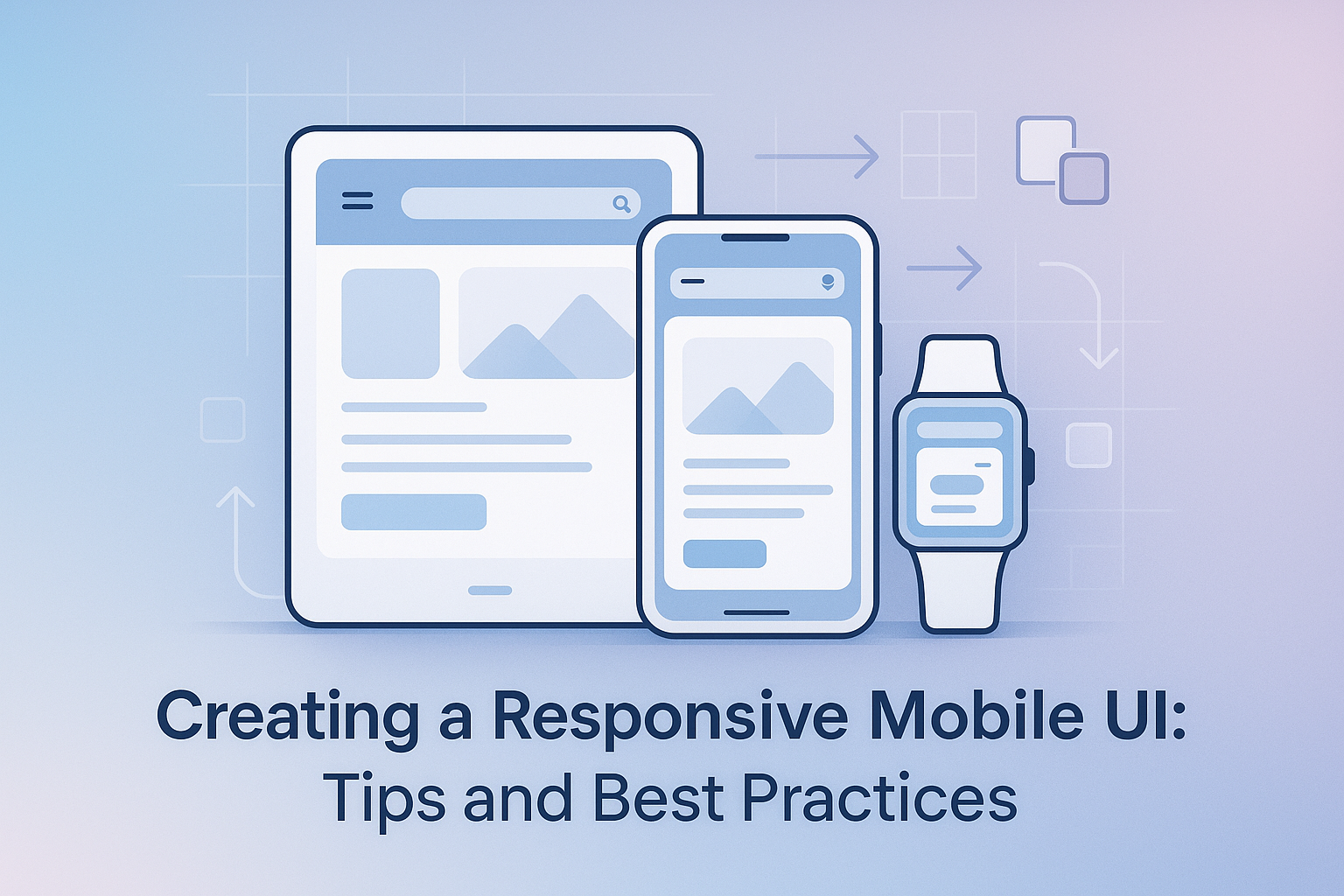Mobile devices have become the primary gateway to the internet for billions of users worldwide. With over 60% of web traffic now coming from mobile devices, creating responsive mobile user interfaces isn’t just a nice-to-have, it’s essential for business success. Whether you’re developing a new app or optimizing an existing one, understanding the fundamentals of responsive mobile UI design can make the difference between an application user’s love and one they quickly abandon.
What Makes a Mobile UI Truly Responsive?
Responsive mobile UI design is about creating interfaces that provide an optimal viewing and interaction experience across a wide range of devices. It goes beyond simply shrinking desktop layouts to fit smaller screens, it’s about reimagining the user experience for various contexts, screen sizes, and interaction models.
The Principles of Responsive Mobile Design
When we talk about responsive design, we’re referring to several core principles:
- Fluid grid layouts that scale proportionally based on the device’s screen size
- Flexible images and media that resize within their containing elements
- Media queries that allow specific styles to be applied based on device characteristics
- Touch-friendly interface elements designed for finger navigation rather than mouse pointers
- Performance optimization that ensures quick loading on various network conditions
Why Responsive Design Matters More Than Ever
In 2025, users expect seamless experiences regardless of what device they’re using. According to recent statistics, users abandon apps that take more than 3 seconds to load, and 88% are unlikely to return to a website after a poor mobile experience. The stakes for getting mobile UI right have never been higher.
The Business Case for Responsive Design
Investing in mobile app development isn’t just about keeping up with trends—it directly impacts your bottom line:
- Higher conversion rates and lower bounce rates
- Improved user engagement and session duration
- Better search engine rankings (Google prioritizes mobile-friendly sites)
- Reduced development and maintenance costs compared to maintaining separate mobile and desktop versions
Essential Components of Effective Mobile UI Design
Intuitive Navigation Systems
Navigation is perhaps the most critical element of mobile UI design. Limited screen real estate means you must be intentional about how users move through your application.
Best Practices for Mobile Navigation:
- Keep it simple – Limit primary navigation to 5 items or fewer
- Use recognizable patterns – Hamburger menus, bottom navigation bars, and tabs are familiar to users
- Provide visual feedback – Users should always know where they are in your app
- Design for one-handed use – Place important interactive elements within thumb reach
- Use clear labels – Icons alone can be ambiguous; combine with text when possible
Optimized Touch Targets
Designing for touch requires different considerations than designing for cursor interaction. Touch targets need to be large enough for human fingers and spaced adequately to prevent accidental taps.
Touch targets should ideally be at least 44×44 pixels, with 8-10 pixels of spacing between clickable elements. High-traffic areas of your app should have even larger touch targets to minimize user frustration.
Responsive Typography
Typography plays a crucial role in mobile UI design, affecting both aesthetics and usability. Text must be legible across devices without requiring users to zoom or squint.
For optimal responsive typography:
- Use relative units (em, rem) rather than fixed pixel sizes
- Establish a clear type hierarchy with 3-4 distinct text sizes
- Maintain adequate line height (usually 1.4-1.5× the font size)
- Set reasonable line lengths (50-75 characters per line)
- Choose fonts designed for screens with good x-height and clear letterforms
Performance-Focused Image Handling
Images often constitute the largest portion of page weight. Improving app loading times should be a priority, with special attention to how images are delivered to mobile devices.
Consider these image optimization techniques:
- Implement responsive images using srcset and sizes attributes
- Use modern formats like WebP or AVIF that offer better compression
- Lazy load images that appear below the fold
- Provide appropriate resolution for the viewing device
- Consider removing non-essential images on mobile views
Key Strategies for Creating Responsive Mobile UIs
Mobile-First Design Approach
The mobile-first approach involves designing for the smallest screen first, then progressively enhancing the experience for larger screens. This methodology forces designers to focus on core content and functionality before adding complexity.
Starting with mobile constraints helps identify the true priorities of your interface. When every pixel counts, you must distinguish between essential and nice-to-have elements. This clarity benefits the user experience across all devices.
Implementing Flexible Grid Systems
Grid systems provide structure while allowing content to reflow based on available space. Modern CSS tools like Flexbox and Grid make implementing responsive layouts more straightforward than ever before.
A typical responsive grid might use:
- 12-column structure for large screens
- 8-column structure for tablets
- 4-column structure for mobile phones
Each component can span a different number of columns based on the viewport size, creating layouts that adapt naturally to various screen dimensions.
Effective Use of Media Queries
Media queries allow you to apply different styles based on device characteristics such as screen width, height, resolution, or orientation. They’re the technical foundation of responsive design.
/* Base styles for all devices */.element { width: 100%;} /* Styles for tablets */@media (min-width: 768px) { .element { width: 50%; }} /* Styles for desktops */@media (min-width: 1024px) { .element { width: 33.33%; }}
While breakpoints based on common device sizes can be helpful starting points, focus on where your content naturally breaks rather than targeting specific devices. This content-first approach creates more future-proof designs.
Smart Form Design for Mobile
Forms are often conversion points and can be particularly challenging on mobile devices. When implementing forms in a responsive UI:
- Minimize input fields to only what’s absolutely necessary
- Use appropriate input types (email, tel, date) to trigger the right mobile keyboard
- Implement autofill whenever possible
- Break long forms into steps or collapsible sections
- Position labels where they’re visible while typing
- Provide clear error messages at the point of error
The mobile app design process should always include special consideration for form optimization, as they directly impact conversion rates.
Technical Implementation Considerations
Choosing the Right Development Framework
The framework you choose significantly impacts your ability to create responsive UIs efficiently. When evaluating mobile app development frameworks, consider:
- Native vs. cross-platform development – Native offers better performance but requires separate codebases; cross-platform enables code sharing but may have performance tradeoffs
- Learning curve and documentation – How quickly can your team become productive?
- Community support and ecosystem – Are there libraries and plugins for common responsive patterns?
- Performance characteristics – How does the framework handle animations and transitions?
- Future compatibility – Is the framework actively maintained and evolving?
For businesses looking to develop applications quickly across platforms, cross-platform mobile app development offers compelling advantages in terms of development efficiency and code maintenance.
Responsive Images Implementation
Modern HTML offers several techniques for responsive images:
<img srcset=”small.jpg 320w, medium.jpg 800w, large.jpg 1200w” sizes=”(max-width: 600px) 100vw, (max-width: 1200px) 50vw, 33vw” src=”fallback.jpg” alt=”Description of the image”/>
This approach delivers appropriately sized images based on both the device’s screen size and resolution, ensuring optimal performance without sacrificing quality.
CSS Best Practices for Responsive Designs
Writing maintainable CSS for responsive designs involves:
- Using a consistent methodology like BEM, SMACSS, or Atomic CSS
- Organizing media queries either by component or by breakpoint
- Embracing CSS variables for recurring values like colors and spacing
- Avoiding fixed heights that can cause overflow issues
- Implementing relative units throughout your stylesheet
These practices create more adaptable layouts and make your codebase easier to maintain as your application evolves.
Testing and Optimizing Responsive Mobile UIs
Comprehensive Testing Approaches
Thorough testing is essential for responsive interfaces. Include these testing methods in your process:
- Device testing on actual hardware representing your user base
- Emulator/simulator testing for quick iterations
- Responsive design mode in browser developer tools
- Automated testing for critical user flows
- Performance testing under various network conditions
Conducting user testing for your mobile app provides invaluable insights that automated testing can’t capture. Observe real users interacting with your interface to identify pain points and opportunities for improvement.
Performance Optimization for Mobile
Performance is a critical aspect of mobile user experience. Strategies to optimize performance include:
- Code splitting to load only what’s needed for the current view
- Asset optimization including image compression and font subsetting
- Strategic caching of static assets
- Reducing third-party scripts that impact loading and interaction
- Implementing skeleton screens instead of spinners for perceived performance
Users expect near-instantaneous interactions with mobile interfaces. Even small improvements in performance can significantly impact user satisfaction and conversion rates.
Accessibility Considerations
Accessible design is responsive design. A truly responsive interface should be usable by everyone, including people with disabilities. Key accessibility practices include:
- Sufficient color contrast for text and interactive elements
- Keyboard navigability for users who can’t use touch interfaces
- Screen reader compatibility with proper ARIA attributes
- Support for text resizing without breaking layouts
- Touch targets large enough for users with motor impairments
Building accessibility into your responsive design process not only expands your potential user base but often leads to better designs for all users.
Advanced Responsive UI Techniques
Adaptive Layouts vs. Responsive Layouts
While responsive layouts use fluid grids and flexible measurements to adapt to different screen sizes, adaptive layouts detect the device type and load a pre-set layout designed specifically for that device class.
Adaptive approaches can offer more tailored experiences for specific contexts but require more maintenance. They’re most appropriate for applications with significantly different use cases across devices.
Content Prioritization Strategies
Not all content should be treated equally across devices. Strategic content prioritization involves:
- Progressive disclosure – Revealing content as users need it
- Feature differentiation – Offering device-appropriate features
- Context-aware layouts – Adjusting based on user context, not just screen size
- Performance budgeting – Allocating loading time based on content importance
When working with an experienced mobile app development company, these content strategies should be part of the planning discussions from the earliest stages.
Motion and Animation in Responsive Design
Thoughtful animation enhances the user experience and provides important feedback. For responsive interfaces:
- Scale animation complexity based on device capabilities
- Use motion to guide attention and indicate relationships
- Provide reduced-motion alternatives for users with vestibular disorders
- Optimize animations for performance using techniques like GPU acceleration
- Test animations across devices for consistency
Well-implemented animations feel natural and enhance usability rather than serving merely as decoration.
Common Pitfalls and How to Avoid Them
Overcomplicating the Interface
One of the most common mistakes in mobile UI design is trying to include too much. This leads to cluttered interfaces that confuse and frustrate users. To avoid this:
- Embrace progressive disclosure – Show only what’s needed at each step
- Use clear visual hierarchy to guide users’ attention
- Eliminate redundant elements that don’t add value
- Question every component – Does it serve the core user needs?
Remember that each additional element adds cognitive load for your users. When in doubt, simplify.
Ignoring Performance Implications
Beautiful designs that perform poorly will ultimately fail. Common performance issues include:
- Unoptimized images that slow down loading
- Heavy JavaScript frameworks that delay interactivity
- Too many http requests from fragmented resources
- Unoptimized fonts that cause text to flash or disappear during loading
Performance should be treated as a design feature, not an afterthought. Mobile app performance optimization is a continuous process throughout development.
Neglecting Mobile Context
Mobile users often have different contexts and goals than desktop users. Failing to account for mobile-specific considerations leads to frustrating experiences. Remember that mobile users may be:
- On slower or intermittent connections
- Using one hand while multitasking
- In bright outdoor environments affecting screen visibility
- More task-focused and time-sensitive
Designing with these contexts in mind creates more useful mobile interfaces.
Future-Proofing Your Mobile UI Design
Embracing Progressive Enhancement
Progressive enhancement builds a core experience that works for all users, then adds enhanced functionality for more capable devices. This approach creates inherently responsive experiences that remain functional across a wide range of contexts.
By separating core content and functionality from their presentation, you create more resilient interfaces that can adapt to future devices and browsers we haven’t even imagined yet.
Preparing for New Device Types
The landscape of devices continues to evolve. Today’s responsive designs need to consider:
- Foldable phones with changing screen dimensions
- Wearable devices with tiny screens
- Smart displays in homes and vehicles
- AR/VR interfaces blending physical and digital worlds
Wearable technology in app development presents unique challenges and opportunities for responsive design as these devices become more mainstream.
Staying Current with Web Standards
Web standards evolve to address new design challenges. Keeping current with emerging techniques helps future-proof your designs:
- Container queries for component-based responsive designs
- Aspect-ratio units for maintaining proportions across screen sizes
- Subgrid for more powerful nested grid layouts
- New viewport units that account for browser interfaces
Following standards rather than proprietary solutions ensures better long-term compatibility and reduces technical debt.
The Role of Prototyping in Responsive Design
Rapid Prototyping Techniques
Prototyping responsive designs before full implementation saves development time and improves final outcomes. Effective prototyping approaches include:
- Low-fidelity wireframes to explore layout options quickly
- Interactive prototypes that demonstrate key interactions
- Responsive prototypes that simulate different device sizes
- Component-based prototyping to test reusable elements
Prototyping in mobile app development helps stakeholders visualize the final product and provides valuable user feedback before significant development resources are invested.
Tools for Responsive Prototyping
Many tools now support responsive prototyping workflows:
- Figma has become an industry standard with powerful responsive design features
- Adobe XD offers device preview and responsive resize capabilities
- Sketch with responsive artboards and symbols
- InVision for creating interactive prototypes
- Webflow for creating high-fidelity responsive prototypes that can transition to production
Tips and tricks for using Figma can significantly accelerate your responsive design workflow, as it’s become one of the most widely used tools in the industry.
Collaborative Approaches to Responsive Design
Developer-Designer Partnerships
Creating effective responsive interfaces requires close collaboration between designers and developers. Successful partnerships include:
- Shared understanding of responsive design principles
- Early developer input on technical feasibility
- Design systems with responsive components
- Clear documentation of responsive behaviors
When businesses hire mobile app developers, they should look for professionals who understand this collaborative approach to responsive design.
Design Systems for Responsive Consistency
A well-crafted design system provides the foundation for consistent responsive interfaces:
- Component libraries that adapt to different contexts
- Responsive spacing scales that maintain proportional relationships
- Documented breakpoints and responsive behaviors
- Accessibility guidelines integrated throughout
Design systems reduce decision fatigue and ensure consistent experiences across an application, regardless of screen size or device type.
Case Study: Responsive Design in Action
Before and After Transformation
Consider an e-commerce app that was initially designed with only desktop users in mind. The original design featured:
- Small touch targets difficult to tap accurately
- Multi-column layouts that became illegible on small screens
- Heavy images that loaded slowly on mobile connections
- Complex navigation requiring precise mouse movements
After implementing responsive design principles, the same application now offers:
- Appropriately sized touch targets for all interactive elements
- Single-column layouts on mobile that expand thoughtfully on larger screens
- Optimized images delivered based on device capabilities
- Simplified navigation with clear touch-friendly menus
- 40% faster loading times on mobile devices
- 25% increase in mobile conversion rates
This transformation was achieved through systematic application of the principles discussed throughout this article.
Conclusion: The Path Forward
Creating responsive mobile UIs is no longer optional—it’s a fundamental requirement for digital success. By embracing responsive design principles, testing thoroughly across devices, and continuously optimizing performance, you can create mobile experiences that delight users and drive business results.
Whether you’re building a new application or enhancing an existing one, the journey toward truly responsive interfaces is ongoing. Technologies and devices will continue to evolve, but the core principles of designing for users’ needs across contexts will remain essential.
For businesses ready to take their mobile user experience to the next level, partnering with an experienced offshore mobile app development team can provide the expertise needed to implement these best practices effectively and efficiently.
Remember that the most successful mobile UIs aren’t just technically responsive—they’re thoughtfully designed to meet users’ needs across the full spectrum of devices and contexts they encounter in their daily lives.







